The most common natural hazards in Malawi are droughts, floods, landslides and earthquakes (WB, 2016).
The National Disaster Preparedness and Relief Committee (NDPRC) is the highest-level body for DRM. The Department of Disaster Management Affairs (DoDMA) coordinates and implements measures to alleviate the effects of disasters, supported by Technical Committees. DRM structures are decentralized and include district, area and village Civil Protection Committees. The DRM National Platform (launched in 2013) is a multi-stakeholder committee that aims to contribute to a comprehensive DRM system for Malawi (UNECA, 2015).
The Government has adopted DRM as one of the core focus areas of the Malawi Growth and Development Strategy (MGDS) and has taken various actions to support climate change adaptation, and has developed the National Climate Change Management Policy, the National Climate Change Investment Plan (2013-2018) and the National Resilience Strategy (2012-2018).
However, the implementation of Sendai framework is constrained by limited investment in DRR, limited assessment and monitoring mechanisms, limited awareness on risk reduction mechanisms and inefficiencies in early warning systems (UNISDR, 2019).
- UNECA (2015). Assessment report on mainstreaming and implementing disaster risk reduction measures in Malawi. Ethiopia: United Nations Economic Commission for Africa.
- UNISDR (2019). Global Platform for Disaster Risk Reduction - Speeches and Statements. Retrieved from https://www.unisdr.org/conference/2019/globalplatform/programme/offic…
- WB (2016). Disaster Risk Profile. Washington: World Bank.
Malawi is an African country, located south of the Equator, mostly hilly and mountainous, and has a tropical climate (or sub-tropical at high altitudes), with a hot and rainy season from mid-November to April and a relatively cool and dry season from mid-May to mid-August (that is, the austral winter). Before the rainy season, from September to November, the temperature rises to the point of reaching the highest levels of the year. Temperatures vary with altitude, and above a thousand meters they are pleasant. However, in the far south, there is a plain region, hot and humid because of the low altitude.
In much of the country, annual precipitation is between 800 and 1,300 millimeters, and it's generally more abundant in the north, where in particular, March and April are very rainy, but also on the southern slopes of Mount Mulanje, where it even exceeds 2,000 mm per year. In the Mulanje Massif, the highest peak of the country is found, called Sapitwa Peak, 3,000 meters high.

Regional Platform / DRR Contact Point
-
Government of MalawiOrganization type:
Risk reduction Policies, Plans & Strategies
Policies, plans and official statements on disaster risk, climate adaptation and resilience.
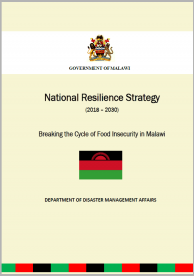
|
National Resilience Strategy (2018-2030) - Breaking the Cycle of Food Insecurity in Malawi
The National Resilience Strategy (NRS) introduces a new sense of common purpose to break the cycle of food insecurity in Malawi by bridging development and humanitarian interventions and prioritizing a continuum of more predictable livelihood support ‘packages’ that target vulnerable households.< |

|
National Disaster Recovery Framework
Recovery efforts defined within the NDRF are guided by a central vision and goal. Following the 2015 floods, an initial vision and goal were determined; these have been updated in response to the 2015/16 drought. |
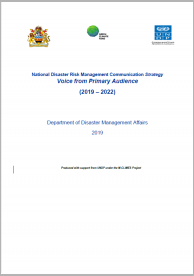
|
National Disaster Risk Management Communication Strategy (2019-2022)
The National Disaster Risk Management Communication Strategy (NDRMCS) has been developed to ensure that those exposed to disasters are informed about the risks and are aware of the measures to prevent, mitigate, prepare for, respond to and recover from these hazards. |
Documents & Publications
Disaster risk reduction and resilience publications, reports, research papers and case studies.
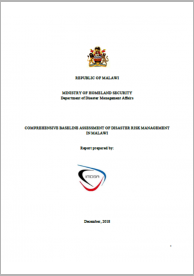
|
Comprehensive Baseline Assessment of Disaster Risk Management in Malawi
This document presents a report of the baseline survey of Disaster Risk Management (DRM) in Malawi. This study was commissioned by the Government of Malawi through the Department of Disaster Management Affairs (DoDMA). The report is organized as follows: |
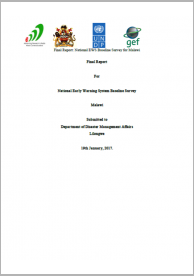
|
Final Report: National Early Warning System Baseline Survey for Malawi
This Final report presents the work done for the National EWS baseline survey as of 19th January, 2017. |
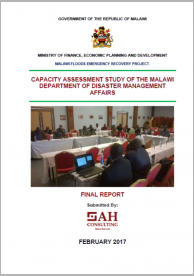
|
Capacity Assessment Study of the Malawi Department of Disaster Management Affairs
This report presents the findings of the study carried out in Malawi between December 2016 and January 2017. It assesses the Capacity of DoDMA to deliver on its mandate, identifies gaps and challenges and makes proposals for Capacity Development. The report is presented in four sections. |
Disaster Data & Statistics
Reports on disaster statistics, country profiles and additional resources on collecting disaster loss data.
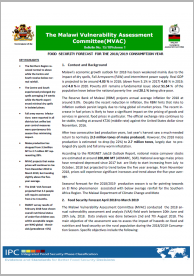
|
Food Security Forecast for the 2018/2019 Consumption Year
The Malawi Vulnerability Assessment Committee (MVAC) conducted the 2018 annual vulnerability assessment and analysis field work between 10th June and 28th July, 2018. Data analysis was done between 2nd and 7th August 2018. |
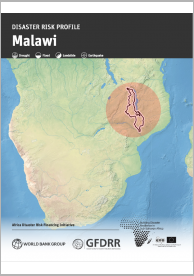
|
Disaster Risk Profile - Malawi
This document outlines disaster risks and impacts in Malawi. The national risk profiles provide the estimated impact of disasters on population, building stock, transport networks, critical facilities, and agriculture at the national and sub-national levels. |
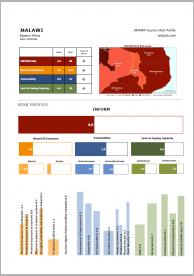
|
INFORM Country Risk Profile - Malawi
Index for Risk Management. |

